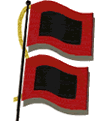Today, June 1, is the first day of the 2006 Atlantic hurricane season. It is also the first day of the Hurricane Central blog.
Why start a hurricane blog? First, I have been fascinated by the weather since I was a child. The interest peaked early, fueled by the violent tornadoes that would blast through the South during early spring. One of my most vivid childhood memories was the so-called
Super Outbreak of tornadoes in April 1974, when 148 twisters killed more than 300 people. One of those killed was my sister's classmate.
I also remember my first hurricane. My uncle was stationed in South Carolina at the time, and we were visiting his family for vacation. Near the end of our stay -- there were maybe one day left -- a hurricane was threatening the Carolina coast. Our parents rushed to pack us up, and we evacuated in the middle of the night. My father's only words: "There's no way in hell I'm staying here another week." Needless to say, my uncle was my mother's brother.
In adulthood, hurricanes and tropical storms entered my professional life. I was a reporter and editor for one of the largest newspaper chains in the United States. I worked at publications all along the Gulf Coast region, including southern Louisiana. We stayed in hurricane mode, it seemed, for a good month or two of the summer. I camped out on a newsroom floor a dozen times, and trekked out to flooded swamps and riverbank areas more times than I care to remember.
When you buy "hurricane clothes" and stock up on emergency supplies each year, you can become complacent. That is, until you look on the radar one morning after a late, boring City Council meeting and see a big blob of red and yellow coming across Cuba. Your heart starts to race a little and the blood pumps a little faster. Finally, a real "story" that doesn't involve zoning variances or street paving.
I ran that race for about 10 years, before I switched over into public relations. Even then, though, I couldn't escape hurricanes. Some of my early clients were large oil-and-gas and shipping companies. I knew these people well and hurricanes' impact upon their business, as I had covered many of them back in the day.
Last year, I entered the blogosphere with a site called
Breakfast at Tiffany's. It has nothing to do with cooking, jewelry or the movie. Half pop culture, half politics mostly. But, as hurricane season became especially rough on the Gulf Coast, I found myself blogging more and more about these storms. As I did, I would say to myself, "This doesn't really fit my blog." But it interested me, so what the hell?
Then came Katrina. As you can see from the BaT archives from
August and
September, I blogged a lot of about her. I once lived in the New Orleans area, and I was profoundly affected by what happen to the Crescent City those few weeks.
I also remember how angry I became at national media coverage of the event. When these air-headed anchors would say (as Katrina veered more toward the Mississippi coastline), "New Orleans dodged a bullet tonight," I would turn red. "Don't these godd*mn idiots know anything about hurricanes?" I screamed to a friend one night. This thing is hundreds of miles wide. The eye is not coming across New Orleans, but there's going to be hell to pay down there. And I don't want to even think what will happen if those levees don't hold."
And the levees didn't.
So in way too many words, that's why this blog begins today. I can't promise daily posts or expert meteorology (although I do seem to have a keen sense for looking at the three-day path and predicting, within a few miles, the landfall city). What I can promise is semi-educated reporting and analysis and, I hope, a place where people can go to learn more about these amazing creatures of nature. It would be grand if others in the strike zones would contribute frontline stories -- but that's the big picture. Let's start small and see what happens.

